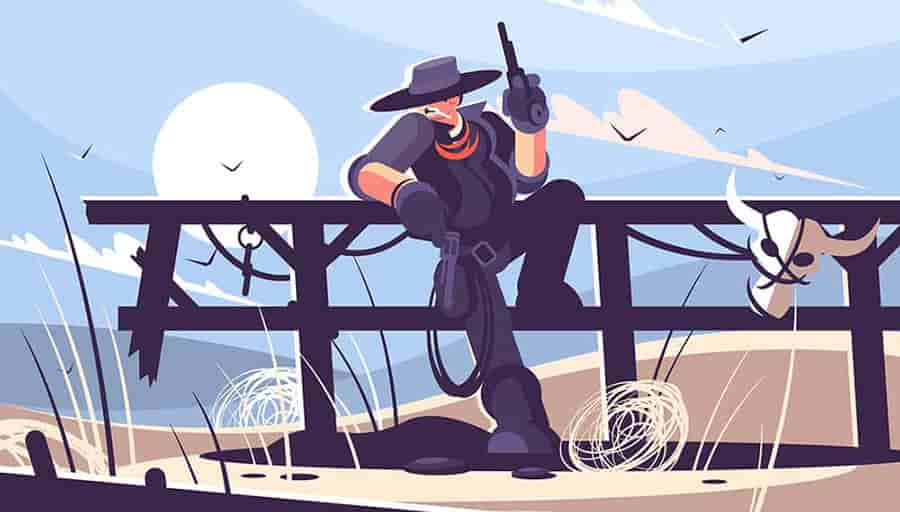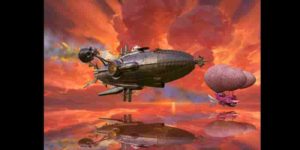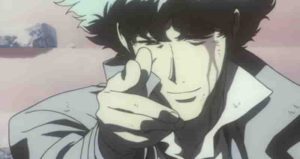Cowboy campaigns can be fascinating territory to explore with D&D 5e. The American Western is rarely blended with fantasy, so there’s room to explore creatively. However, we can look at the examples we do have, such as Stephen King’s Dark Tower series, Indiana Jones, or even the monster classic Tremors. All we need is six-shooters and something from the beyond and, bam, we have cowboys in a world of magic, myth and monsters.
So, how do cowboys work in DnD 5e?
Luckily, we have plenty of material to use, both in story and game mechanics. I’ve re-skinned a few classes to fit cowboy-style characters. Let’s take a look at some factors to consider in building a gun-slinging Western campaign.
For a DnD 5e Cowboy campaign, consider the following elements.
- Understand the game mechanics of wild west tech
- World build around an arid desert setting
- Consider Western story tropes: redemption, revenge, exploration
- The Lone Gunman (Fighter/Gunslinger)
- The Priest (Cleric)
- The Snake Oil Salesman (Rogue Mastermind)
- The Bounty Hunter (Ranger)
Understand the game mechanics of wild west tech
Naturally, we need to understand the most obvious change in play—the weapons.
Legends of the Wild West live and die by the emerging six-shooter technology, a necessity in the frontier. Therefore, we need to know what the mechanics of 1800’s firearms—revolvers, rifles and shotguns—are and how to implement them with other combat mechanics.
The revolver deals 2d8 piercing damage with a range that most creatures can’t escape and a reload of 6 shots. In the mechanics of D&D, I can wield two six-shooters. Or, I could still use a sword in my other hand, keeping it epic.
The rifle (hunting rifle) deals 2d10 piercing damage. The range is much longer, with a reload of 5 shots. Naturally, I’ll need two-hands to use this weapon, but the damage output is well worth the effort.
Finally, the shotgun fires off 2d8 piercing, and has the shortest range. Because I’d likely be homebrewing this one anyway, I’ll suggest we add a pushing effect within a certain amount of distance. Otherwise, it doesn’t make sense to use compared with the revolver.
World build around an arid desert setting
Really, I could set this story in a number of locations, but the desert has a certain cowboy appeal that could be used to world build.
Even within the concept of a “desert”, I have variations. For example, my arid landscape could be rocky and mountainous, like parts of the southwest United States. On the hand, I could make the desert more of a sandy, Saharan landscape. The whole purpose is to have a world anchored in inspiration. I could include cave systems, an oasis, abandoned temples, pyramids, a scorpion farm, entire villages made of cacti—whatever is relatable to a desert.
With a particular ecosystem in mind, alongside a set of genre tropes to implement, I can get creative in my adventure options. Off the rip, I think about Indiana Jones or the Brendan Frasier Mummy franchise—a cowboy in search of a lost treasure, facing the mythical forces of the unknown.
Another movie inspiration I could go with is Tremors. As I mentioned before, this movie is classic cowboy and monster action, with a couple of broke wranglers facing off against a prehistoric worm monster. The concept would be a small, colony town invaded by monsters of the area. I could literally use the same kind of worm monster in my campaign.
Of course, there’s always classic campaign ideas—the search for treasure, undead invaders, save the so-and-so—that can still be used. However, now it’s taking place with upgraded, Wild West technology. Don’t be afraid to build a world with desert kingdoms, magic, monsters, guns and trains.
Related Posts:
Guide to Building Pirate Campaigns and Characters: DnD 5e
| Guide to Building Steampunk Campaigns: DnD 5e
|
Monsters and Minions
Speaking of desert monsters, let’s think of this as a creative exercise in bringing the Monster Manual into this world.
As I mentioned before, the worm is a great place to start—borrowing from out Tremors example or even much larger as seen in the Dune series. For Dungeons and Dragons, this creature is called a purple worm. Normally, these purple worms are found in the Underdark, obviously tunneling as a way of transportation. However, we can create a situation where these gargantuan monstrosities come to the surface.
Think of other wild monsters that might call the desert home—reptiles, scorpions, giant birds, scavengers, desert-dwelling beasts—and have fun with it. For example, a basilisk could be built more like a Gila monster, or a treant could be built as a giant, walking cactus.
I could have plenty of fun choosing an undead campaign in the desert. Movies like John Carpenter’s Vampires, From Dusk til Dawn and The Mummy are great sources of inspiration for gunslingers against the undead (maybe better stated as an “undead western”). We could fill this game with classic vampires, necromancers and walking dead with touches of the desert. For example, my zombies could be lesser mummies, drained of fluids and dry as a bone, or my vampires could employ bat-like gargoyles, giving their minions a New Mexico bat flavor.
Don’t be afraid to make the monsters in this campaign tougher than normal. Guns do a lot of damage.
Magic and Technology
As I mentioned before, building this world for both fantasy and 1800’s technology will be a creative exercise in and of itself.
To me, this essentially means putting on my steampunk hat and pulling the most interesting elements from both genres. Kingdoms will appear across the vast desert, and trains will carry passengers safely through the expanse. I could even implement a couple of wranglers and bounty hunters to keep these trains safe or hunt monsters that threaten the smaller towns in between.
Obviously, this world is going to have gunmen. But, let’s not forget about the spellcasters and melee warriors. I’d imagine most players would be a combination of both—packing heat, a sword and probably a few spells. Remember, everything the heroes have the villains have too, so don’t forget bad guys with guns. Goblins could be fun in this regard.
Consider western story tropes: redemption, revenge, exploration
With an idea for the setting, think about characters within this world that have connections to player characters.
I’d imagine most people playing this sort of campaign would have seen a Western or two—or at least a Western-inspired blockbuster. I’m a firm believer in playing with character tropes and leaning into (at least a little bit) the roleplaying aspects. It’s surprising how boring a campaign can become when fighting is all there is to do.
Backstories with arch-nemeses can make for much more exciting gameplay. Or maybe you’re the guy with a criminal history looking to protect something precious. Perhaps the priest who lost his family to vampires was forced to pick up a gun. Maybe an old purple worm hunter is out for one last hurrah. When the players have fleshed out characters, they add to the gameplay and create epic moments.
For examples of how to re-skin character classes for a cowboy Western, consider the following.
The Lone Gunman (Fighter/Gunslinger)
Think Clint Eastwood meets Billy the Kid. This is a classic gunslinger, a high-noon quickdraw with two six-shooters—the one-man army, the fastest gun in the West.
For this guy, I could use the homebrew gunslinger class, which is easy to find online. However, the basic fighter classes can be utilized to great effect for a gun fighter. The Champion archetype, for instance, grants me in an improved critical at level 3, and the Battlemaster grants me 3 maneuvers. Naturally, I’ll choose the Two-Weapon fighting style.
As far as the maneuvers go, I’ll pick Precision Attack, Riposte and Maneuvering Attack. The Precision Attack adds a superiority die (1d6) to my attack roll, effectively increasing my aim. Riposte will allow me to counterattack when a creature misses, which essentially grants me a free extra attack in the combat round. Finally, Maneuvering Attack allows a buddy to move without triggering opportunity attacks, like laying down cover fire.
The Priest (Cleric)
The priest plays on the Western story trope of redemption, often used as a conflicted character between the ways of peace and the way of the gun. Plus, in a supernatural setting, they make perfect vampire hunters.
In our Dungeons and Dragons setup, this character translates to the cleric. There are several Domains of devotion to choose from, but for the undead slaying vibe I want, I’ll choose the Domain of Light. Along with the special spells I receive with this domain (burning hands, flaming sphere, etc.), I’ll use my class abilities to rid the world of evil.
Don’t forget, this class comes with a choice of melee weapon and ranged crossbow. A crossbow might be a cool aesthetic for a vampire hunter, but I’d be willing to trade it out for a firearm (a shotgun, maybe).
The Snake Oil Salesman (Rogue Mastermind)
The snake oil salesman is the Wild West version of a hustler, a convincing rogue. More specifically, a rogue mastermind from Xanathar’s Guide to Everything could be your team swindler.
I like to imagine this guy as a wisecracking, talkative shmuck with a little hat. He’s not rocking a full-size cowboy hat. Nope, he’s a city man out to make a buck. However, he’s too smart not to carry a revolver in his coat and hide a few tricks up his sleeve.
Played with all the sneaking, trap-disarming, underworld connected goodness of a rogue, this character will survive the wild. The extra mastermind abilities will give me access to disguise kits and a gambling set. This character could be interesting in setting up a game of poker, which is another classic trope of the cowboy.
This guy almost reminds me of the Wizard of Oz (the actual guy, not just the movie).
The Bounty Hunter (Ranger)
Did somebody say Chuck Norris?
Lone Wolf McQuaid here lives by his own code of honor and was raised in the wild. This guy is a long-range rifle sort, bringing his bounty in more-so dead than alive. But don’t be fooled, he’ll know his way around a knife and have the Dexterity score to prove it. As far as fighting styles, I would allow the Archery bonus to work for guns.
Either of the basic 2 ranger archetypes would fit Lone Wolf McQuaid. The Hunter could give me added damage against enemies, while the Beastmaster could grant me an actual wolf. Either way, this character is going to have a strong affinity for nature. I’ll definitely choose Animal Handling and/or Nature as a proficiency, alongside Sneak and Survival.
I’ll likely choose animal-based ranger spells as well, learning the secrets of the wild. Speak with Animals will be a must, as well as the classic Hunter’s Mark.
What kind of cowboy character would you build?
Let me know! Did I miss anything?
Related Posts:
Guide to Building Underground Campaigns: DnD 5e
| Cowboy Bebop: Is Spike Spiegel Actually Dead?
|
Disclaimer:
Genre Bomb is unofficial Fan Content permitted under the Fan Content Policy. Not approved/endorsed by Wizards. Portions of the materials used are property of Wizards of the Coast. ©Wizards of the Coast LLC.





